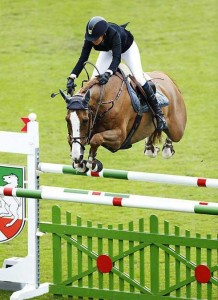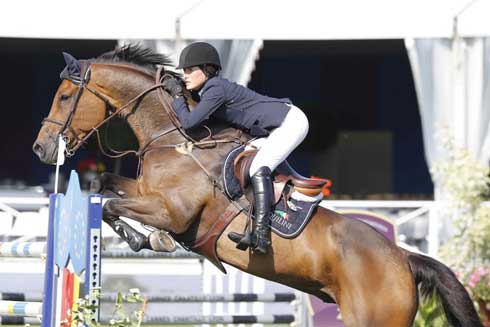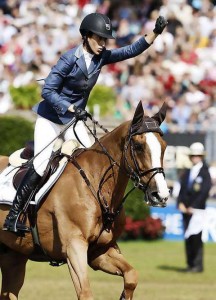Jumper Prices Soar
By Paula Parisi September 21, 2013
Swiss rider Janika Sprunger and Palloubet d'Halong earlier this year. (Photo courtesy of the horse's Facebook page)
A raft of high-profile show jumping horse sales has the industry talking. Most recent and splashy of the news is Dutch entrepreneur Jan Tops’ purchase, at a reported $14.8 million (€11 million), of Palloubet d’Halong, a 10- year-old Selle Francais gelding owned by Switzerland’s Hansueli Sprunger and until recently under saddle to his 26-year-old daughter, Janika.
Although early reports centered on Tops procuring the horse for his wife, Edwina Tops Alexander (AUS), at press time that was not confirmed. Indeed, some say it is likely he was acting on behalf of a Qatari client. This summer Tops assumed duties coaching the Qatari national team.
“Jan is probably the most successful sales agent there is, but he’s not a billionaire, and it doesn’t seem possible he would be buying his wife a $15 million horse,” said one U.S.-based sales agent who deals in European stock. The broker, who spoke on condition of anonymity, also noted that a bit of hyperbole surrounds some of the most talked-up transactions. “You hear these prices, and then you talk to the buyers who say they only paid a quarter as much. There is a lot of speculation.”
A case in point is Meredith Michaels-Beerbaum’s reported sale of the talented Bella Donna 66 to Ukrainian rich guy Oleksandr Onyshchenko, whom recent press accounts claim was ready to offer $7 million. German rider Ulrich Kirchhoff is currently competing Onyshchenko’s horses, including Carlina IV, the lovely mare previously ridden by Pius Schwizer (SUI). Carlina VI traded hands in March. Bella Donna 66, however, is still property of Michaels-Beerbaum’s EOS partnership and esconced at the Michaels-Beerbaum family farm in Thedinghausen.
That doesn’t mean a sale won’t eventually take place, but it does mean reports of a transaction with the mare’s passport stamped for the Eastern Bloc were premature. At such cost, these are intricate deals – price is haggled over, details deliberated, not to mention the often-agonizing decision to part with a successful teammate.
A complicating factor is that there are now buyers for whom price need not be an issue. If they really want the horse, they can, make the proverbial offer that can’t be refused. The Sprungers are said to have rebuffed initial approaches only to have them escalate after the horse achieved fame at the Furusiyya Nations Cup in La Baule in May (one of only two double clears, to help the Swiss team finish second).

Meredith Michaels-Beerbaum and Bella Donna 66 win the AIG Thermal $1 Million Grand Prix in March. (Flying Horse Photography)
Likewise, after Bella Donna soared through a seemingly impossible Conrad Holmfeld course to win the AIG $1 Million Grand Prix on the HITS Desert Circuit in Thermal, CA, in March, inquiries came pouring in.
“The quality of horse shows has increased so much in the past 10 years,” said Sharn Wordley, the principal rider at Ashland Stables, with operations in Wellington, FL, and Lexington, KY. On Sept. 7 Worldley placed third in the Zoetis $1 Million Grand Prix in Saugerties, NY, riding the Ashland mare Derly Chin De Muze.
“Promoters of big horse shows are now catering to the really wealthy with events like the Gucci Masters in Paris and the Longines Global Champions Tour [founded by Tops in 1996]. These events have made the sport very interesting to an elite type of client,” added Wordley, a New Zealander who is building an Ashland Stables sales operation with newly-opened offices in Belgium.
“Horse prices have been steadily going up for the last five years, but now we’re seeing the prices really starting to rocket,” Wordley continued. “The main change is, 15 years ago the only buyers paying the million-dollar-plus-prices were in the United States. Now we’re seeing all these new countries come on line – countries with massive wealth and a desire to distinguish themselves in the sport. Russia, the Ukraine, the Middle East… even China. There aren’t really more great horses being bred, but there are more billionaires buying them.”

Vindicat W clinched Team Gold for Great Britain at the 2012 Olympics and was immediately purchased by Jessica Springsteen, who very effectively competed the horse on the Longines Global Champions Tour this summer. (Photo by Stefano Grasso / GCT)
Phillip Rozon, an FEI judge based in Bromont, Canada, has witnessed the goings on at the highest level of the international sport. He characterizes the situation succinctly: “The guy who manages the Saudi Arabian team has a personal mandate to buy 50 of the greatest horses in the world, and an unlimited budget to do it. He wants his riders not only to compete on the best horses, but also to train on them. He’s getting results.”
Since 2008 the Saudi team has had Dutchman Rogier van Iersel as chef d’equipe, with countryman Stanny Van Paesschen joining as coach in 2009. In 2010 the KSA’s Abdullah Al Sharbatly purchased the mare Seldana di Campalto as an Olympic hopeful and rode into history, winning the Silver medal at the 2010 Alltech World Equestrian Games in Kentucky. The Kingdom of Saudi Arabia team went on to stun the world by winning Bronze at the 2012 Olympics in London (prompting Al Arabia News to speculate “Did Saudi Arabia’s Olympic Bronze Cost $49 Million?”)
So while prices may be exaggerated, there is no doubt they’ve quite decisively gone up. Prior to the purchase of Palloubet d’Halong the record sales price for an Olympic-discipline horse was for the Dutch dressage mount Totilas, who changed hands circa 2011 for a price reported at more than $12 million. As a stallion with breeding potential, that cost was rationalized. For a gelding to sell for nearly $15 million is raising eyebrows.

Palloubet and Sprunger were one of only two pair to deliver a double clear round at the Furisaya Nation's Cup in La Baule. (Photo courtesy of the horse's Facebook page)
“You have people buying horses for $2 million to $3 million for their kids to ride,” Rozon said. “Part of it is that these are proven horses that can be reliedy on to get safely get over the biggest jumps.” Doting parents Bruce Springsteen and Patti Scialfa bought daugher Jessica Murka’s the 10-year-old Vindicat W (also a gelding) virtually as it exited the track at the 2012 Olympics in London, a Team Gold medal clanging around its rider’s neck. Though price was not disclosed, the U.K.’s Daily Mail reported that “recently top class showjumpers have changed hands for as much as $8 million.”
Rozon’s fellow Canadian, Quebec-based sales agent François Lamontagne recently sold a California-based rider barely out of the juniors a horse he purchased as a three-year-old and brought along. Lamontagne’s price, $2.5 million. The results the duo have achieved make that appear to have been a bargain.
“He had borrowed money to start his farm, and with that one sale he was able to pay off all his debts and buy some new horses. So if you’re smart and can spot talent, you can do very well as a horse dealer,” Rozon said.
“Even the kids are very ambitious,” added our anonymous source. “These riders want to make the national team and win a medal at the top of the sport. There are very few horses that can do that, and all of them are a couple of million dollars.”
Short URL: https://theequestriannews.com/?p=17532


